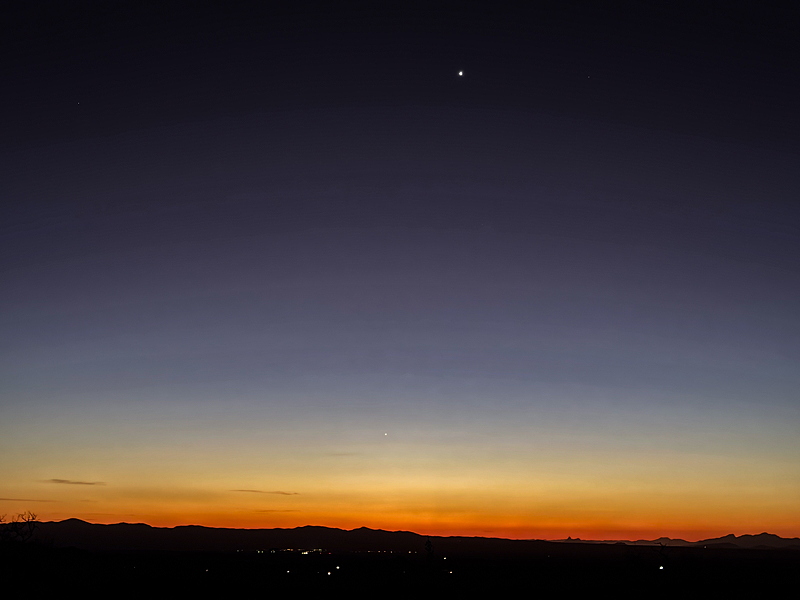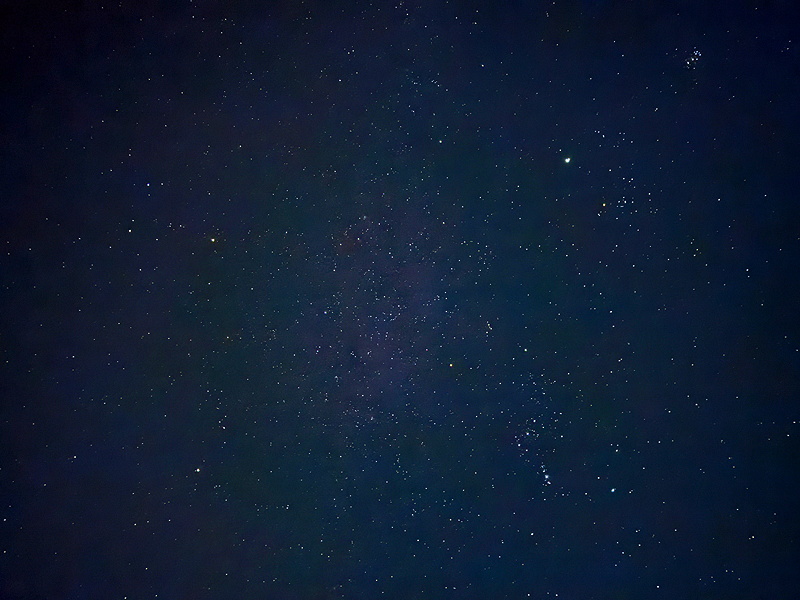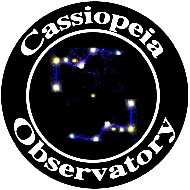Venus & Mercury, Thor's Helmet Nebula
Posted: 27 February 2025
Due to an early morning meeting the next day with some local ex-military fighter pilots, I did not open the observatory Tuesday night, 25 February 2025.
|
Open: Wednesday, 26 February 2025, 1815 MST Temperature: 83°F |
Session: 2076 Conditions: Clear |
Equipment:
12" f/8 LX600 w/StarLock
2" 24mm UWA eyepiece
Focal reducer
2" UHC filter
Camera:
iPhone 15 Pro Max
D850 DSLR
1818 MST: Sunset.
1823 MST: LX600 ON, StarLock OFF, High Precision OFF.
Viewed Venus, 102X. A nice crescent phase was visible. Viewed Mercury, 102X. A small disk was seen.
Prepared the D850 DSLR for imaging.
1837 MST: Relaxed on the observatory patio bench.
1840 MST: Did some planet viewing using 12x50 binoculars:
Venus; the crescent phase was visible.
Mercury.
Jupiter; two moons were visible.
Mars.
1850 MST: Mercury was now visible with the naked eye.
1901 MST: iPhone 15 Pro Max photo taken with the Camera app (Night Mode, 7 seconds, 2X lens).

Mouseover or tap on image for labels
1918 MST: iPhone 15 Pro Max photo taken with the Camera app (Night Mode, 10 seconds, 2X lens). Mars in the constellation of Gemini, Jupiter in Taurus, the Pleiades, and the Winter Milky Way to the left of the constellation of Orion are visible.

Mouseover or tap on image for labels
1930 MST: The Zodiacal Light was visible in the western sky.
1932 MST: Back in the observatory. High Precision ON.
Slewed to NGC2359 (Thor's Helmet Nebula). Some faint nebulosity was visible, 102X.
Mounted the D850 DSLR camera at prime focus + focal reducer + UHC filter, focused on the star Sirius, locked the telescope mirror, and slewed to NGC2359.
1942 MST: StarLock ON.
After doing two short framing test images, I began doing StarLock autoguided, ISO 4000, exposures of NGC2359 (Thor's Helmet Nebula). Unfortunately poor seeing resulted in poor autoguiding. I finally gave up doing any imaging on this session. This is the only usable image I got (278 seconds).

I will image Thor's Helmet Nebula on a future session. I have imaged it several times in the past with different cameras and filters.
2000 MST: StarLock OFF.
Viewed NGC1977 (Running Man Nebula), 102X. I enjoy viewing and photographing this nebula. I included an image that I had taken on the cover of my autobiography Finding my Way to the Stars.
2009 MST: LX600 OFF.
2019 MST: Took a Sky Quality reading and reported the result to Globe at Night.
|
Close: Wednesday, 26 February 2025, 2023 MST Temperature: 63°F |
Session Length: 2h 08m Conditions: Clear, SQM 20.65 |
Comments are welcome using Email. Please read the Email Etiquette guidance.
Cassiopeia Observatory Home Page
Copyright ©2025 Michael L. Weasner / mweasner@mac.com.
URL = http://www.weasner.com/co/Reports/2025/02/27/index.html
